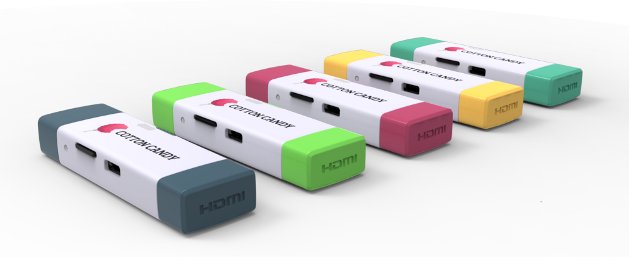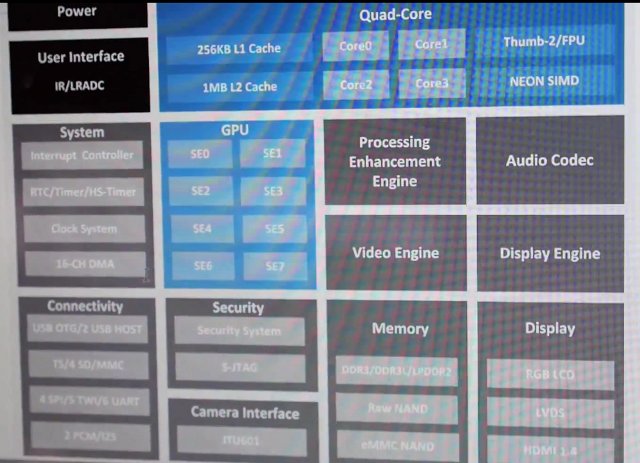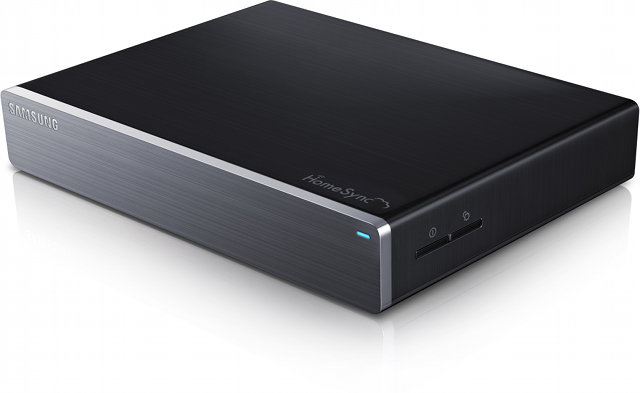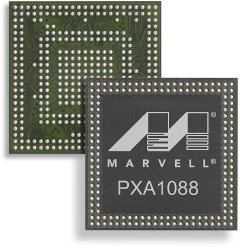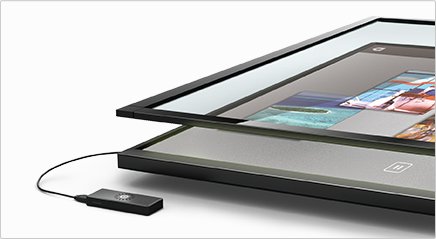As announced at CES 2013, Dell will be the first multinational company to enter the Android mini PC with Project Ophelia, a mini PC powered by Rockchip RK3066 with 1 GB RAM and 8 GB Flash, which would just be an American copy of Chinese products without support for MHL, and PocketCloud, a software suite to access your computers’ desktop remotely, create your own private cloud, and manage your devices remotely. The specifications have not been disclosed, but I could gather some specs mainly from CNET: SoC- Rockchip RK3066 Dual Core Cortex A9 @ 1.6Ghz System Memory – 1GB RAM Storage – 8GB Flash + micro SD Connectivity: Bluetooth Wi-Fi 802.11 b/g/n (with push to connect button) Video Output – HDMI / MHL USB – microUSB Dimensions – 8.89cm x 3.81cm You can either power the device via MHL if you have a compatible television, or via USB like most […]
FXI Technologies Cotton Candy HDMI Stick To Fully Support Both Android and Ubuntu
FXI Technologies was the first company to ever show an HDMI TV dongle when they unveiled the Cotton Candy in November 2011. Since then, many Chinese companies started to provide similar products at lower cost, and the company further improved the Cotton Candy, which is still powered by Exynos 4210 (dual core Cortex A9), by making it even smaller, and getting rid of the internal flash in the process. As a memory refresher, here are the specifications of the Cotton Candy: SoC – Samsung Exynos 4210 dual core Cortex A9 + Mali-400MP4 System Memory – 1GB DRAM Storage – No flash, up to 64GB microSD Video Output – HDMI Connectibity Wifi 802.11b/g/n Bluetooth 2.1 + EDR USB – USB 2.0 male connector for power and connection to devices that supports USB mass storage + microUSB Video Codecs- 480p/720p/1080p Decode of MPEG4-SP/H.263/H.264 AVC/MPEG-2/VC1 Audio Codecs – MP3, AAC, AAC+, Real Audio […]
How to Run Android Apps in Linux with AndroVM
You may want to run some Android applications in your computer. If you’re using Windows, there’s already a decent option with Bluestacks. If you’re using Linux, you could always install the Android SDK and run the emulator, but I don’t really like this option because of the user interface, and for people who don’t need to use the SDK it’s not really the simplest thing to install. The way to run Android apps in Linux is probably to run an x86 Android virtual machine in VirtualBox. Yesterday, I tried the latest development version of Android x86 4.2, but for some reasons I could not control the mouse, and had to perform all tasks with the keyboard. What I’m going to use today instead is AndroVM, an Android VM for x86 processor, that is even more easy to use than the Android x86 image. The instructions has been performed in a […]
Linaro 13.02 Release with Linux Kernel 3.8 and Android 4.2.2
Linaro 13.02 is now available, and features Linux Kernel 3.8 and Android 4.2.2. The biggest news this month is probably the first release of a preliminary ARM64 Debian/Ubuntu Raring image. Other noticeable items include work on ARMv7 KVM, more improvements to OpenEmbedded ARMv8 implementation, as well as big.LITTLE MP implementation, and some modifications to the toolchain for Cortex A7 support. Origen images are not available for download this month, and there’s still no ALIP images since they have disappeared since Linaro upgraded to Ubuntu Quantal. Here are the highlights of this release: Android AOSP master build for Galaxy Nexus has been setup All the platforms have been updated to 4.2.2 Support for lava-test-shell has been added to linaro-android-build-tools. Developer Platform CI bring up: ARMv7 KVM – Add Arndale hypervisor patch to u-boot-linaro. CI bring up: Arndale – Add Arndale image reports to LAVA, Enable and verify UEFI support in the […]
AllWinner Announces A31s Processor for Phablets, Hints about Ubuntu Devices
AllWinner is currently a Mobile World Congress 2013, and Charbax had the chance to interview Eva, manager at AllWinner, and learn more about new processors, and future plans by the company. They spent some time discussing about AllWinner A31 and AllWinner A20 quad and dual Cortex A7 processors, but since we’ve know about those for a while I’ll skip this part. The most interesting part is about AllWinner A31s, a cost down version of A31, specifically designed for phablets (smartphones with 5″ to 7″ screens). Like AllWinner A31, AllWinner A31s is also a quad core Cortex A7 processor with PowerVR SGX544MP2 GPU (8 shader engines) and the following specifications: CPU – ARM Cortex-A7 Quad-Core with 256KB L1-Cache/1MB L2-Cache GPU – POWERVR SGX 544MP2 with 8 logic cores. OpenGL ES2.0, Open CL1.x and DX 9_3 compliant. Memory 32-bit Dual-Channel LPDDR2/DDR3/DDR3L Controller, 8-bit NAND FLASH Controller with 64-bit ECC Video UHD H.264 […]
Samsung HomeSync Media Server Comes with a Dual Core Processor, 1TB Storage
Yesterday, Samsung announced the HomeSync, a media server featuring a dual core processor at 1.7 GHz, 1GB RAM, 8GB eMMC, and a 1TB hard drive. HomeSync is said to be running a modified version of Android Jelly Bean. Here are HomeSync specifications: Processor – Dual Core @ 1.7GHz (I’d guess it should be the Exynos 5250, but why all the mystery?) System Memory – 1GB DDR3 Storage – 8GB eMMC + 1TB HDD Connectivity LAN – Gigabit Ethernet WiFi – 802.11 b/g/n 2.4GHz & a/n 5GHz HT40 2×2 MIMO Channel Bonding Bluetooth – V4.0 USB – 2x USB 3.0 Host, 1x Micro USB (11pin) Video Output – HDMI out Audio – Optical Audio (Audio Amp. Connection) Video Codec – H.264, H.263, MPEG4, VC-1, Sorenson Spark, WMV7/8, MP43, VP8, DivX Audio Codec – MP3, AAC LC/AAC+/eAAC+, WMA 9std/10pro/Lossless, FLAC, Vorbis, AMR-NB/WB, Wav, Mid, AC-3 DRM – HDCP 1.3/2.1, Playready, Widevide, Trustzone […]
Marvell PXA1088 Quad Core Cortex A7 SoC
Marvell has just announced the MarvellPXA1088, a quad-core Cortex A7 application and communications mobile SoC that integrates Marvell’s WCDMA and TD-SCDMA modem technology to provide a low-cost 3G platform for both smartphones and tablets. Marvell’s mobile platform also includes Avastar 88W8777 WLAN + Bluetooth 4.0 + FM single-chip SoC, L2000 GNSS Hybrid Location Processor, and an integrated power management and audio codec IC. PXA1088 is said to be pin-to-pin compatible with the earlier PXA988/PXA986 solutions (dual core SoC) so that current mobile device designs can be upgraded with a quad-core SoC without additional development costs. Additional PXA1088 Features: Support for advanced WCDMA Release 7, TD-SCDMA HSPA+ Release 8, and class 12 EDGE 3G protocol stack certified on all major carrier networks and validated via IOT, GCF and field trail testing Support for popular full-feature operating systems (Including Android 4.2), and industry-standard development tools Multi-radio platform capabilities with WLAN/Bluetooth solutions Integrated […]
PQ Labs iStick A200 Android mini PC Connects to G4 Series Multi-Touch Screens
PQ Labs iStick A200 is a Rockchip RK3066 Android 4.1.1 mini PC with 2 GB RAM, 4 GB Flash, an HDMI (female) output, a USB 2.0 Host port, and a miniUSB port for power. Pretty boring stuff if you ask me… And I would not be writing about it, if the company hadn’t interfaced their infrared touch frames to this mini PC to allow 10-point multi-touch on a large screen or projector output, making it a pretty good solution for conferences and interactive digital signage. Before going further, let’s have a look at the details of specifications for the iStick A200: SoC – ARM Cortex A9 Dual Core @ 1.6Ghz with HyperSpeed (Equivalent to 2.0Ghz Dual Core) and Quad Core Mali400 GPU (cnxsoft: It has to be Rockchip RK3066) System Memory – 2 GB DRAM chipset Storage – 4 GB NAND flash + microSD socket (Up to 32 GB) Video […]



